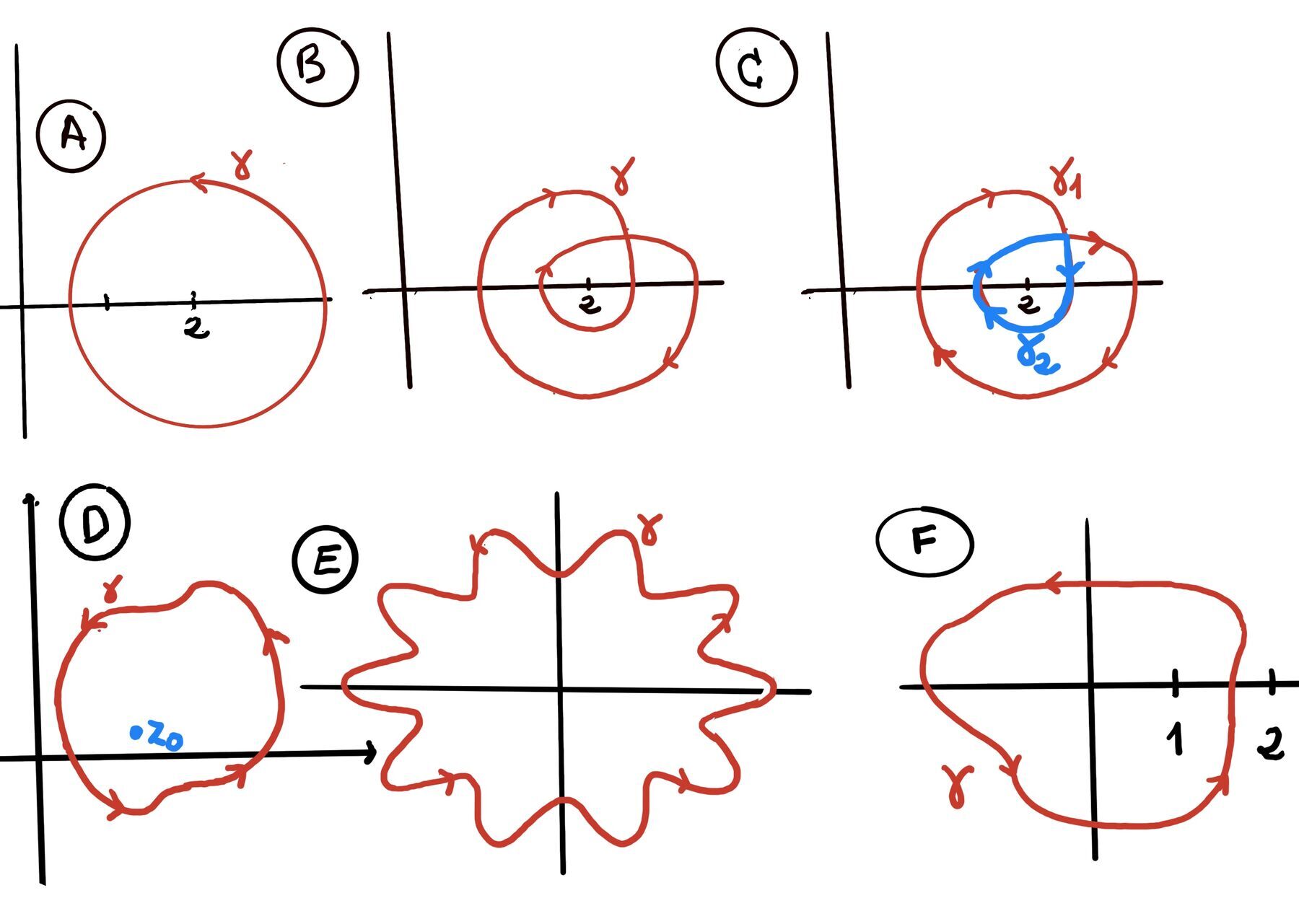
|
 |
 |
The computer was born to solve problems that did not exist before, Anonymous

A complex function $f(z)$ maps $z = x + iy \in \mathbb{C}$ to another complex number. For example: $f(z) = z^2 = (x + iy)^2 = x^2 - y^2 + 2ixy, f(z) = \frac{1}{z}, f(z) = \sqrt{z^2 + 7}$.
A contour is a continuous, piecewise-smooth curve defined parametrically as: $z(t) = x(t) + iy(t), \quad a \leq t \leq b$. Examples of contours:
Definition (Smooth Contour Integral). Let ᵞ be a smooth contour (a continuously differentiable path in the complex plane), $\gamma: [a, b] \to \mathbb{C}$. Let $f: \gamma^* \to \mathbb{C}$ be a continuous complex-valued function defined on the trace $\gamma^*$ of the contour (i.e. along the image of $\gamma$). Then, the contour integral of f along $\gamma$ is defined as $\int_{\gamma} f(z)dz := \int_{a}^{b} f(\gamma(t)) \gamma^{'}(t)dt$.

The Fundamental Theorem of Calculus in complex analysis extends the classical real-variable theorem to contour integrals in the complex plane. It provides a method to evaluate integrals over paths in the complex domain using antiderivatives, simplifying calculations and linking complex differentiation and integration.
Fundamental Theorem of Calculus for Contours. Suppose $\gamma$ is a contour (piecewise smooth path) from a to b, f is defined on a domain D containing $\gamma^*$ (the image of $\gamma$) and admits a primitive (antiderivative) F on D (i.e., $F'(z) = f(z)$), then $\int_{\gamma} f(z)dz = F(\gamma(b)) - F(\gamma(a))$. In particular, if $\gamma$ is a closed contour (i.e., $\gamma(a)=\gamma(b)$), this integral evaluates to zero, $\int_{\gamma} f(z)dz = 0.$
This result mirrors the real case $\int_a^b f(x)dx = F(b)-F(a)$, but generalized to curves in the complex plane. The crucial requirements are:
These guarantee that the integral of the derivative collapses neatly to the difference in endpoint values. In other words, it establishes path independence. When a function has an antiderivative, the value of its integral between two points depends only on the endpoints, not the specific contour or path taken between them.
Parameterize the contour: $z=\gamma(t)$ with $t \in [a,b]$. Then, $\int_\gamma f(z)dz = \int_a^b F'(\gamma(t))\gamma'(t)dt$.
Assume that $\gamma$ is smooth, then $F \circ \gamma$ is differentiable. By the chain rule, $\frac{d}{dt}[F(\gamma(t))] = F'(\gamma(t))\gamma'(t)$. Thus:
$\int_a^b F'(\gamma(t))\gamma'(t)dt = \int_a^b \frac{d}{dt}[F(\gamma(t))]dt = \int_a^b Re(\frac{d}{dt}[F(\gamma(t))])dt + i\cdot \int_a^b Im(\frac{d}{dt}[F(\gamma(t))])dt$
By the fundamental theorem of calculus for real integrals:
$Re(F(\gamma(t)))\Big|_a^b + i\cdot Im(F(\gamma(t)))\Big|_a^b = F(\gamma(t))\Big|_a^b = F(\gamma(b)) - F(\gamma(a))$
$\int_a^b \frac{d}{dt}[F(\gamma(t))]dt = F(\gamma(t))\Big|_a^b = F(\gamma(b)) - F(\gamma(a))$
By the Fundamental Theorem: $\int_\gamma z^2 dz = F(1) - F(0) = \frac{1^3}{3} - \frac{0^3}{3} = \frac{1}{3}.$
By the Fundamental Theorem of Calculus for Contour Integrals: $\int_{\gamma_1} 2z dz = F(1+i) - F(0) = (1+i)^2 - 0^2 = 1+2i-1 = 2i.$
$\int_{\gamma_2*\gamma_3} 2z dz = F(1+i) - F(0) = 2i.$
$\int_{\gamma_1} 2z dz = \int_{\gamma_2*\gamma_3} 2z dz = 2i$. The difference between these two paths forms a closed contour. Since f is analytic, Cauchy’s theorem implies the integral over this closed contour is zero, so the two integrals (contour integrals are linear) must be equal. This demonstrates path independence, a consequence of Cauchy’s theorem.
Define the closed contour $\Gamma = \gamma_1 - (\gamma_2 * \gamma_3)$, i.e., traverse $\gamma_1$ from 0 to 1 + i, then traverse $\gamma_2 * \gamma_3$ in reverse from 1 + i back to 0. Since f(z) = 2z is entire (analytic everywhere), Cauchy’s Integral Theorem gives: $\int_\Gamma f(z) dz = 0.$
By linearity of contour integrals: $\int_\Gamma f(z) dz = \int_{\gamma_1} f(z) dz - \int_{\gamma_2 * \gamma_3} f(z) dz = 0$. Hence, $\int_{\gamma_1} f(z) dz = \int_{\gamma_2 * \gamma_3} f(z) dz$.
Integrating an Exponential Function. Consider $f(z) = e^z$, which is entire (analytic on all of ℂ). Let $\gamma(t)=e^{it}, t\in[0,2\pi]$ be a circular contour (closed loop) of radius 1 centered at the origin (unit circle). Since f is entire, it has an antiderivative on ℂ. Indeed, $F(z) = e^z$ satisfies $F'(z) = e^z = f(z)$. By de Fundamental Theorem of Calculus for Contour Integrals, $\int_\gamma f(z)dz = \int_\gamma e^zdz = F(\gamma(2\pi)) - F(\gamma(0))$. But $\gamma(2\pi)=\gamma(0)=1$, so the difference vanishes F(1) − F(1) = 0. Hence: $\int_\gamma e^zdz = 0$. This result is also consistent with Cauchy’s Integral Theorem, which states that the integral of an analytic function over a closed contour is zero.
Closed contour case. Consider $f(z) = cos(z)$, which is entire (analytic on all of ℂ). Let $\gamma(t)=e^{it}, t\in[0,2\pi]$ be a circular contour (closed loop) of radius 1 centered at the origin (unit circle). Since f is entire, it has an antiderivative on ℂ. Indeed, $F(z) = sin(z)$ satisfies $F'(z) = cos(z) = f(z)$. By de Fundamental Theorem of Calculus for Contour Integrals, $\int_\gamma f(z)dz = \int_\gamma cos(z)dz = F(\gamma(2\pi)) - F(\gamma(0))$. But $\gamma(2\pi)=\gamma(0)=1$, so the difference vanishes F(1) − F(1) = 0. Hence: $\int_\gamma cos(z)dz = 0$. This result is also consistent with Cauchy’s Integral Theorem, which states that the integral of an analytic function over a closed contour is zero.
Nonlinear path. Consider $f(z) = \frac{1}{z}$. It is analytic on ℂ∖{0}. Its admits an antiderivative $F(z)=\log(z)$ but the complex logarithm is multi-valued. To make it single-valued, we choose a branch cut — across that ray the chosen branch of arg is discontinuous.
Here, we define: F(z) = log(z) = ln∣z∣ + iarg(z), with $arg(z) \in (-\frac{\pi}{2}, \frac{3\pi}{2}]$. This choice places the branch cut along the negative imaginary axis, i.e., the set {z ∈ ℂ: Re(z) = 0, Im(z) < 0}. The function is defined and single-valued on $\mathbb{C}$ minus the negative imaginary axis.
If a point approaches the cut from the right (quadrant IV side) the argument approaches $\tfrac{3\pi}{2}$; approaching from the left (quadrant III side) it approaches $-\tfrac{\pi}{2}$. The jump in argument is $\tfrac{3\pi}{2} -\bigl(-\tfrac{\pi}{2}\bigr)=2\pi$, so the logarithm has a jump of $2\pi i$ across the cut.
On this branch, F(z) is analytic on ℂ ∖ {negative imaginary axis} and satisfies $F'(z) = f(z) = \frac{1}{z}$. Consider the contour $\gamma(t)=e^{it}$, $t\in[0,\pi]$ which traces the upper semicircle from z = 1 to z = −1.
At t = 0: γ(0) = 1, arg(1) = 0. At t = π: γ(π) = 1, arg(π) = 1.The arguments along γ range from 0 to π, which lies entirely within the interval $(-\frac{\pi}{2}, \frac{3\pi}{2}]$. Therefore, the contour γ does not cross the branch cut along the negative imaginary axis.
Since F(z) is analytic on a domain containing γ, we can apply the Fundamental Theorem for Contour Integrals:
$\int_\gamma \frac{1}{z}dz = F(-1)-F(1)$.
Using our chosen branch: F(−1) = ln∣−1∣ + iarg(−1) = 0+ iπ = iπ, F(1) = ln∣1∣ +iarg(1) = 0 + i(0) = 0.
$\int_\gamma \frac{1}{z}dz = F(-1)-F(1) =iπ − 0 = iπ$.
An antiderivative F(z) such that F′(z) = f(z) is $F(z) = z^3$.
Since $f(z) = 3z^2$ is analytic everywhere and $F(z) = z^3$ is an antiderivative, the fundamental theorem for contour integrals gives: $\int_{\gamma} 3z^2dz = F(\gamma(1)) - F(\gamma(0))$.
(2+i)² = 4 + 4i + i² = 4 + 4i −1 = 3 + 4i, (2 + i)³ =(2 + i)(3 + 4i) = 6 + 8i + 3i + 4i² = 6 + 11i −4 = 2 + 11i.
Substitute the endpoints: $F(\gamma(0)) = (i)^3 = -i, F(\gamma(1)) = (2+i)^3 = 8 + 12i - 6 - i = 2 + 11i$.
Therefore: $\int_{\gamma} 3z^2dz = (2 + 11i) - (-i) = 2 + 12i.$
The contour is a straight line segment from a straight line from γ(0) = 0 to γ(2) = $2e^{i\pi/4} =[\text{Using Euler’s formula}]2(\cos(\pi/4)+i\sin(\pi/4))=2(\frac{\sqrt{2}}{2}+i\frac{\sqrt{2}}{2})=\sqrt{2} + i\sqrt{2}$.
Since $f(z) = e^z$ is analytic everywhere and $F(z) = e^z$ is an antiderivative, the fundamental theorem for contour integrals gives:
$\int_\gamma e^zdz = F(\gamma(2)) - F(\gamma(0))$
Substitute the endpoints: $F(γ(0))=F(0)=e^0=1, F(γ(2))= e^{\sqrt{2} + i\sqrt{2}} = e^{\sqrt{2}} \cdot e^{i\sqrt{2}} = e^{\sqrt{2}}(\cos(\sqrt{2}) + i\sin(\sqrt{2}))$
$\int_\gamma e^zdz = F(\gamma(2)) - F(\gamma(0)) = e^{\sqrt{2}}(\cos(\sqrt{2}) + i\sin(\sqrt{2})) - 1$
Final result:
$\boxed{\int_\gamma e^zdz = e^{\sqrt{2}}\big(\cos(\sqrt{2}) + i\sin(\sqrt{2})\big) - 1}$